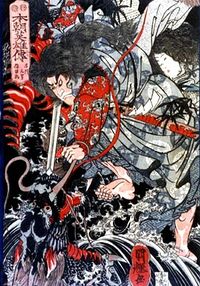Momotarō

Momotarō (桃太郎) is a popular hero from Japanese folklore. His name literally means Peach Tarō; as Tarō is a common Japanese boy's name, it is often translated as Peach Boy. Momotarō is also the title of various books, films, and other works that portray the tale of this hero.
Contents |
Story
According to the present form of the tale (dating to the Edo period), Momotarō came to Earth inside a giant peach, which was found floating down a river by an old, childless woman who was washing clothes there. The woman and her husband discovered the child when they tried to open the peach to eat it. The child explained that he had been sent by Heaven to be their son. The couple named him Momotarō, from momo (peach) and tarō (eldest son in the family).[1]
Years later, Momotarō left his parents to fight a band of marauding oni (demons or ogres) on a distant island. En route, Momotarō met and befriended a talking dog, monkey, and pheasant, who agreed to help him in his quest. At the island, Momotarō and his animal friends penetrated the demons' fort and beat the band of demons into surrendering. Momotarō and his new friends returned home with the demons' plundered treasure and the demon chief as a captive. Momotarō and his family lived comfortably from then on.[1]
An older form of the story has the old, childless woman discover the giant, floating peach and take it home with her, as she finds it to be of good color and tasty-looking. After eating a piece of the peach, the old woman is suddenly rejuvenated and regains the beauty of her youth. When her old husband comes home from the hills, he is astounded to find a dazzling young lady in his house. At first he does not even recognize his own wife in her rejuvenated form, but she explains to him how she has picked up an unusual peach floating in the river and brought it home to eat it and was magically transformed. She then gives her husband a piece of the peach to eat, and he also regains his youthful vigor. That night, the newly invigorated couple make love, and the woman becomes pregnant as a result. She eventually gives birth to their first child, a son, whom they name Tarō, as that is a common Japanese name for a first son.
Momotarō is strongly associated with Okayama, and his tale may have its origins there. The demon island (Onigashima) of the story is sometimes associated with Megijima Island, an island in the Inland Sea near Takamatsu, due to the vast manmade caves found on that island.[2][3]
Variants
There are a few variants to the story, depending on geographical region. Some say Momotaro floated by in a box, a white peach, or a red peach. Stories from Shikoku and Chugoku region muddy the distinction with characters from another folk story, the Monkey-Crab Battle[4] that Momotaro took with him allies to Oni Island, namely a bee (蜂 hachi), a crab (蟹 kani), a mill stone (臼 usu), a chestnut (栗 kuri), and a cowpie (牛の糞 ushi no hun).[5] In old days, all these animals and objects were believed to possess spirits and could move by their own will. The cowpie was sometimes given the honorific dono (殿). This was to appease the cowpie spirit, so as it won't move to be under you when you stumble or take a step.
Momotarō's song
The popular children's song about Momotarō titled Momotarō-san no Uta (Momotarō's Song) was first published in 1911. One version of it is included below with romanization and translation.
« Momotarō-san no uta » 桃太郎さんの歌
Momotarō-san, momotarō-san (Momotarō, Momotarō) 桃太郎さん、桃太郎さん
Okoshi ni tsuketa kibidango (Those millet dumplings on your waist) お腰につけたきびだんご
Hitotsu watashi ni kudasai na? (Won't you give me one?) 一つ私に下さいな!
Agemashō, agemashō (I'll give you one, I'll give you one) あげましょう、あげましょう
Kore kara oni no seibatsu ni (From now, on a quest to conquer the ogres) これから鬼の征伐に
Tsuite kuru nara agemashō (If you come with me, I'll give one to you) ついてくるならあげましょう
References
- ↑ 1.0 1.1 Ozaki, Yei Theodora (1903). "Momotaro, or the story of the Son of a Peach". The Japanese Fairy Book. Archibald Constable & Co.. http://books.google.com/books?id=V_RyPbadxJgC.
- ↑ "Oni-ga-shima(or Megijima)". Archived from the original on 2008-01-10. http://web.archive.org/web/20080110004627/http://www.city.takamatsu.kagawa.jp/english/kankou/B1e.html. Retrieved 2010-09-01.
- ↑ "Megi-jima/Ogi-jima". Takamatsu City Web Site. http://www.city.takamatsu.kagawa.jp/english/sightseeing/spot/megi-jimaogi-jima.html. Retrieved 2010-09-01.
- ↑ See saru-kani kassen (さるかに合戦?, "Monkey-Crab Battle") on Japanese-language Wikipedia.
- ↑ "桃太郎". Archived from the original on 2008-02-08. http://web.archive.org/web/20080208142021/http://www.f49m24.niknak.ne.jp/~kire/sub1-21.htm. Retrieved 2010-09-01. (Japanese)
See also
- Folklore
- Urashima Tarō
- Kintarō
|
|||||||||||||||||||||||||||||||||||||||||

